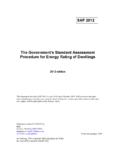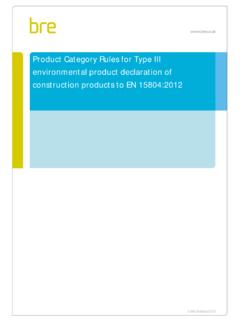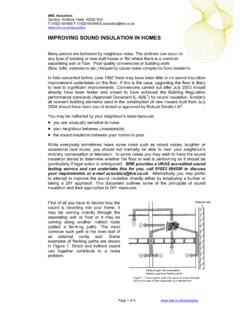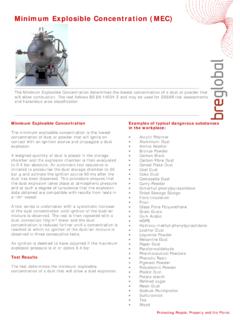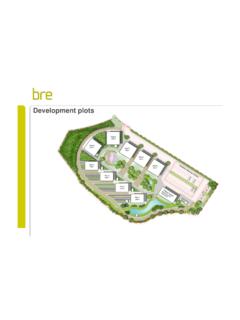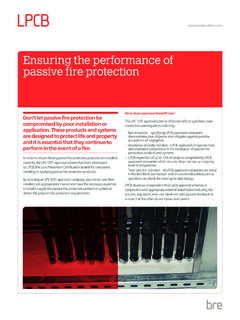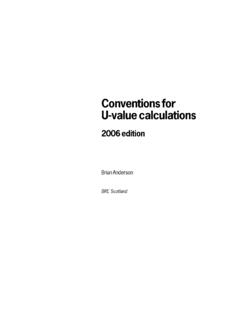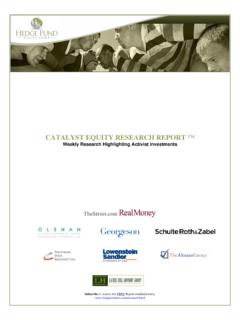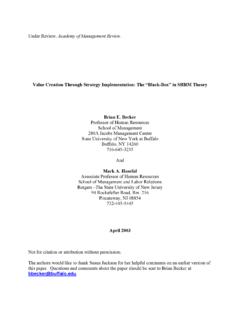Transcription of THE NEXT BIG THING - BRE
1 CONSTRUCTION. SITE TRANSPORT. THE next BIG THING . Why transport is important What you can do about it April 2003. Transport accounts for 10-20% of construction costs. CBI estimate the annual cost of road congestion to the economy is 20 billion. Construction vehicles account for a proportion of this congestion, and construction sites suffer with poor reliability of deliveries. Reducing site transport is possible, and can cut costs. Financial and productivity benefits of adopting a more efficient approach to transport and logistics include: reduced fuel and delivery costs;. increased delivery efficiency and reliability;. reduced costs for parking;. increased profitability. BAA has estimated that its workforce spend 10-40% of their time dealing with ordering and transporting materials to where they are needed.
2 Logistics professionals estimate that if transport and logistics were dealt with more efficiently, trades people would be free to concentrate on their core areas, reducing staff and materials costs by 15%. This leaflet summarises a BRE study to develop indicators for construction site transport funded by DTI. Department of Trade and Industry WHY TRANSPORT IS IMPORTANT. CONGESTION CHARGING. Congestion charging is a reality in central London, with another 30-40 local authorities considering the implementation of similar schemes. Recent coverage in Building' shows how the charge is affecting the construction industry. Examples publicised in Building' show that delivery companies' are over-charging, and smaller companies' margins are being threatened.
3 The Mayor Ken Livingstone has ruled out an exemption for construction vehicles. Nicky Gavron (the deputy mayor) has stated that the industry needs to prove that measures to control transport are being taken. Public or private vehicles with nine or more seats can apply for exemption, so organising workforce transport can help. Lorry pooling and using green fuel' vehicles will reduce transport and allow exemption. FREIGHT ROAD USER CHARGING. In the 2002 Budget, The Chancellor committed to introducing distance-based freight road user charging by 2006. This will probably be an electronic system that will operate via a global positioning system (GPS). DEVELOPMENT CONTROL. Increasing numbers of planning authorities are considering construction site transport as part of the consent.
4 They require accurate estimations of road transport according to the design and work plan. When information is not needed for an application, it can still be required for planning the site management. Transport issues can only be addressed if they are accounted for from inception, including the design team and supply chain. YOUR PEOPLE. Transport has a large impact on quality of life for the workforce and the surrounding community: it is a key aspect to address under Corporate Social Responsibility and Health and Safety. Improvements in the transport associated with a construction project will benefit clients and contractors through: improved image and community relations for the client, contractor and the users of the finished product.
5 Fewer accidents on site and in the surrounding area;. a more productive workforce, who have had their transport problems considered, are dealing with fewer complaints and are enabled by effective deliveries. OUR ENVIRONMENT. Construction transport accounts for 13% of UK fuel use1. This makes it a key target for reduction to meet climate change protection policies. Road vehicle pollution also causes acidification and low level ozone, both of which have negative impacts on human health. Companies are now reporting on such environmental concerns, and looking to minimise their impacts. Measuring and controlling construction site transport helps to improve the rating when seeking certification of new projects through schemes such as BRE's Environmental Assessment Method (BREEAM) and the Civil Engineering Environmental Quality Assessment (CEEQUAL).
6 1 The Construction Industry Mass Balace. Viridis 2002. WHAT YOU CAN DO ABOUT IT. MEASUREMENT. All these pressures mean transport must be managed. As the old adage put it, you need to measure to manage. The BRE study has taken the M4I environmental performance indicator2 on transport as a starting point. Indicators allow: clients to specify performance and assess achievement;. designers to compare the performance of methods and materials they specify;. contractors and the supply chain to measure and improve performance. The indicators simply consider road vehicle movements and road vehicle distance for workforce and commercial traffic (see tables 1 and 2). Straightforward calculations have been developed for cost and emissions. Table One Definition Number of road vehicle movements to site, per 100,000 project value.
7 Consider: " Workforce movements " Delivery of materials and plant to site " Movement of waste off site Methods Workforce Either during construction, or on completion, using induction questions, actual numbers of vehicles in on site car parks, or security records, ascertain the total number of workforce vehicle movements onto site and the value of the project completed. Commercial Either during construction, or on completion, using security or other gate records, contractor notes and waste transfer notes, ascertain the total number of commercial vehicle movements onto site and the value of the project completed. Total Performance score (workforce and commercial vehicle movements per 100,000) = Total number of workforce and commercial vehicle movements 100,000.
8 Value of the project completed Example Without on-site parking, the induction question yielded the following data: 70% drive in their own car, 10% share a van with one other, 10% drive on a motorbike, 10% come by public transport. On average 100 people come to site every working day. Therefore there are on average 85 vehicle movements daily (70 singly occupied cars, 5 shared vans, 10 motorbikes, ignore public transport.). From records kept at the gate, it is known that during the project, there were 1000 deliveries to site and 250 waste vehicles arrived. With 100 working days on site and a project value of 1M, the workforce and commercial vehicle movements per 100,000. project value is: (85 100) + 1250. ---------------- -------------- 100,000 = 875.
9 1,000,000. 2 Table Two Definition The distance (km) vehicles travel to site, per 100,000 of project value. Consider: " Workforce movements " Delivery of materials and plant to site " Movement of waste off site Methods Workforce Either during construction, or on completion, using induction questions, and travel diaries, ascertain the total workforce distance travelled onto site and the value of the project completed. Commercial Either during construction, or on completion, using security or other gate records, contractor notes and waste transfer notes, ascertain the total distance travelled by commercial vehicles and the value of the project completed. Total Performance score (workforce and commercial vehicle distance per 100,000) = Total number of workforce and commercial kilometres 100,000.
10 Value of the project completed Example The induction question was used to calculate the average round-trip distance travelled for each transport mode: the car drivers come 30 km on average, van drivers 40 km, the motorcyclists 50 km, ignore public transport. (Remembering that 70% drive in their own car, 10% share a van with one other, 10% drive on a motorbike, 10% come by public transport.). On average 100 people come to site every working day, there were 100 working days on site, with a project value of 1M. The suppliers kept records of mileage attributable to the site (ie when a vehicle was loaded 50% or more with a load for or from the site). The 1000 deliveries resulted in 10,000 km. The 250 waste deliveries were all by the same vehicle type, all to the same waste management site 25 km away, resulting in 12500 km.

